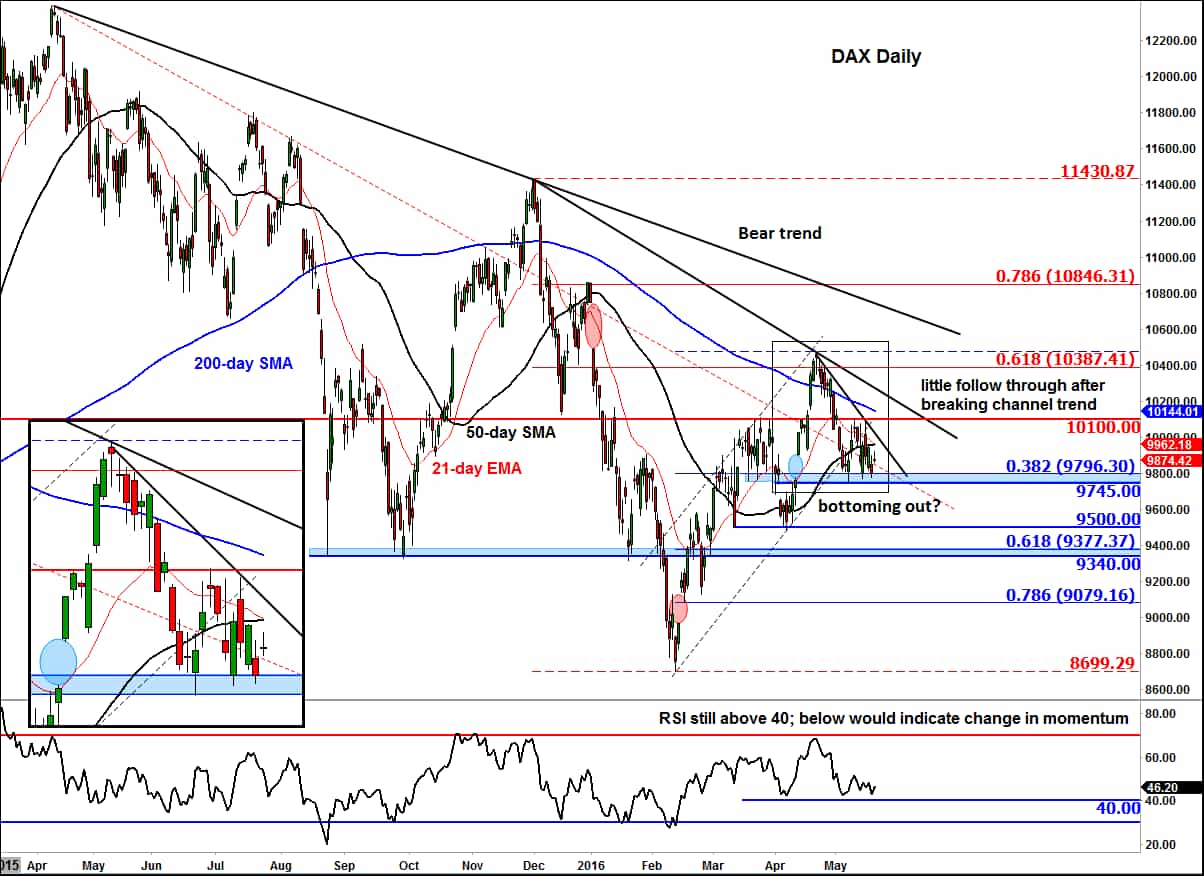European stock indices have enjoyed a short-covering bounce that began late in the day on Thursday when Wall Street shares managed to erase most of their earlier declines. At midday in London, the UK’s FTSE 100 was up 1.2% and Germany’s DAX was 0.7% higher.
Sentiment had turned sour in mid-week following the publication of the FOMC’s surprisingly hawkish April meeting minutes as traders fretted about the economic impact of a potentially earlier-than-expected interest rate rise in the US. The minutes revealed that most Federal Reserve policymakers believed a rate rise would be "appropriate" at the June meeting should economic conditions continue to strengthen as expected and inflation heads back towards the 2 per cent target.
As well as impacting stocks, the hawkish minutes caused the US dollar to rally as bond prices fell and yields rose. Buck-denominated gold, silver and oil prices retreated, which in turn weighed further on commodity-linked stocks.
On Friday, however, traders were making a more sober assessment of the hawkish Fed minutes, with sentiment boosted further by a sharp recovery in oil prices towards $50 a barrel. Speculators wondered whether the markets were overreacting to all this? After all, the FOMC was apparently less concerned about the economic impact of a rate rise at the last meeting because of a slightly weaker dollar, stronger equity markets and overall better financial conditions then. But since the April meeting, the dollar had already appreciated a little. And now that it has gained more noticeably and the stock markets have fallen slightly, don’t be surprised if the Fed starts to talk down the prospects of a June rate hike in the coming weeks. Unfortunately, this is what the markets have been reduced to!
ECB support offset by Brexit risks, growth concerns
Despite Friday’s rally, European markets still remain in medium-term consolidation mode. Stocks are still held back, among other things, by lingering Brexit risks, renewed concerns about China and the lack of any significant economic growth in the Eurozone despite all the monetary support from the European Central Bank. But the ECB’s corporate bond buying programme is set to start in June. Yields on these bonds have already been falling in anticipation of the purchases, but they could fall a lot further when the ECB actually enters the market next month.
This could drive investors further away from fixed-income and into the higher-yielding equity markets. And given the growing divergence of monetary policy between the US and Eurozone central banks, European stocks could soon start to outperform those on Wall Street.
Looking forward to next week
But in the short-term, Brexit concerns are likely to hold back some European investors until the June 23 referendum is out of the way. In addition, next week’s Eurogroup meetings in Japan to discuss a top up to Greece's bailout payments may also hold back some bullish traders in the first few days of the new week.
Meanwhile both the economic and earnings calendars are fairly light next week. But we will still have some key European data – mostly from the economic powerhouse, Germany – to look forward to:
- Monday: Eurozone Manufacturing and Services PMIs
- Tuesday: German ZEW Economic Sentiment
- Wednesday: German Ifo Consumer Climate and German Business Climate
- Thursday: The second estimate for UK first quarter GDP; US durable goods orders and unemployment claims
- Friday: Preliminary US Q1 GDP (i.e. this is the second estimate – the ‘advanced’ estimate was released last week)
On a micro level, some of next week’s key European corporate events include:
- Monday: Ryanair Holdings (Full Year 2015/16 Earnings)
- Tuesday: Kingfisher (Trading Statement)
- Wednesday: Dixons Carphone (Trading Statement); Marks & Spencer (Full Year 2015/16 Earnings)
Technical outlook: DAX set to end consolidation with a bang?
From a technical point of view, the European stock market rebound on Friday was a continuation of the move from late Thursday when the S&P 500 failed to sustain its break below the neckline of a Head and Shoulders pattern, which we had covered HERE on Wednesday.
The last time we looked at the DAX index was on May 6 (see "DAX: make or break time" for more). As it turned out, there was no break then but the corresponding bounce failed to materialise into a significant rally as it faltered ahead of prior resistance at 10100; now it is back to square one.
That being said, the lack of any significant follow-through in the selling pressure after the break out form the bullish channel shows the sellers have struggled to maintain control. Sensing this bearish weakness, the bulls may step in now and push the index decisively higher. On the upside, traders may first and foremost want to watch the first of the three bearish trend lines now, around the 10K mark. Above here, horizontal resistance and prior highs at 10100 come into play ahead of the 200-day moving average at 10145 next.
The above bullish scenario would become invalid in the short-term if support at 9745-9795 area breaks down first. If so, a move towards 9500 or the 61.8% Fibonacci retracement around 9375 area would then become likely.




